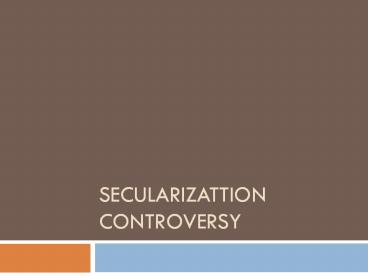secularization PowerPoint PPT Presentation
Title: secularization
1
SECULARIZATTION CONTROVERSY
2
Secularization
- a process by which the society is slowly
transforming from that having close
identification with the religious institution to
a more separated relationship. - was considered to be the dawn of Philippine
Nationalism, particularly after the execution of
Gomburza.
3
Secularism
- began in 1861 when the parishes of Mindanao
originally managed by the Recollect friars were
handed to the Jesuits. - The Jesuits were expelled from the Philippines in
1768 because of the conflict they had between the
European leaders. However, they returned to the
country in 1861 and regain power over the
Mindanao parishes from the Recollects who took
over during their absence. - The Recollects were bestowed the parishes of
Manila and Caviteby the colonial government to
appeased their loss. - The original administrators of the parishes, the
Filipino secular priests, naturally protested.
4
The Seculars
- those who were not bound by monastic vows or
rules. - discriminated by the Dominicans, Jesuits,
Franciscans and Recollects - The Filipino priests then were assigned as
assistants to Spanish friars.
5
The Gomburza
- headed the secularization movement.
- an acronym for Fathers Mariano Gomez, Jose
Apolonio Burgos, and Jacinto Zamora, three
Filipino priests who were executed on February17,
1872 by Spanish colonial authorities on
trumped-up charges of subversion arising from the
1872 Cavite mutiny. - advocated the right of the Filipino secular
clergy over the assignment of parishes rather
than giving them to the newly arrived Spanish
friars in the country.
6
The Gomburza
- The uprising by workers in the Cavite Naval Yard
was the pretext needed by the authorities to
redress a perceived humiliation from the
principal objective, Father Jose Burgos, a rising
star who, by dint of intellectual gifts and
scholastic achievement, threatened the
established order. - Father Burgos was Spanish Mestizo, a Doctor of
Philosophy whose prominence extended even in
Spain, such that when the new Governor and
Captain-General Carlos Maria de la Torre arrived
from Spain to assume his duties, he invited
Father Burgos to sit beside him in his carriage
during the inaugural procession, a place
traditionally reserved for the Archbishop and
who, as expected, was a Peninsular Spaniard.
7
The Gomburza
- The arrival of the liberal governor de la Torre
was not welcomed by the ruling minority of
friars, regular priests who belonged to an order
(Dominicans, Augustinians, Recollects,
Franciscans) and their minions in civil
government, but mistakenly embraced by the
secular priests, majority of these Mestizos and
natives or Indios assigned to parishes and
far-flung communities, who believed the reforms
and the equality they sought with Peninsular
Spaniards were at hand. - In less than two years de la Torre was replaced
by Governor-General Izquierdo who turned out to
be a pliant tool of the friars.
8
The Gomburza
- The so-called Cavite Mutiny of workers in the
arsenal in the naval shipyard over pay reduction
owing to increased taxation produced a willing
witness to implicate the three priests, who were
summarily tried and sentenced to death by
'garrote. - Father Gómez, the oldest, went to his death
heroically. - Father Zamora, the youngest, guileless and
totally befuddled, died with a whimper. - Father Burgos, hoping for a reprieve which never
came and scanning the distance till the very last
moment, met his death soaked in his own tears.
9
The Gomburza
- Their unjust execution enraged and left a
profound and bitter effect on many Filipinos,
especially Joe Rizal, the national hero, who,
himself, was to suffer a mock trial leading to
his execution. - Significantly, in the archives of Spain, there is
no record of how Izquierdo, himself a liberal,
could have been influenced to authorize these
executions.
10
The Gomburza Aftermath
- The aftermath of the witch hunt produced scores
of suspects most of whom were exiled to Guam in
the Marianas, who, except a few who managed to
escape to other ports like Hong Kong, died there
in neediness. - It was a period when a pall of hopelessness
enveloped the country, steeling the resolve and
patriotism of a sentient minority, giving rise to
a new generation of heroes of whom the Rizal
family was to become the standard bearer.

